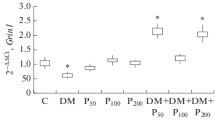Abstract
The effects of peptide geroprotectors, such as cortexin and pinealon, on the training of rats of different ages and the caspase-3 system in their brain structures were studied in the experimental model of acute hypoxic hypoxy. Regional changes were identified in the activity and the content of caspase-3 in the cerebral cortex and brainstem structures of young and old rats under the influence of peptide preparations. It is suggested that the functional state of the caspase-3 system in the brain is one of the reasons for the ability of animals to learn. Compared with cortexin, pinealon has a greater positive effect on the learning of both young and old animals in the Morris labyrinth.
Similar content being viewed by others
References
Barkhatov, D.Yu., Konovalov, R.N., and Fedin, P.A., Efficiency of neuroprotection in therapy of cognitive dysfunctions at chronic brain ischemia, Russ. Med. Zh., 2011, no. 30, pp. 1884–1890.
Gulyaeva, N.V., “Apoptotic” mechanisms in normal brain plasticity: caspase-3 and long-term potentiation, Zh. Vyssh. Nervn. Deyat., 2004, vol. 54, no. 4, pp. 437–447.
Kozina L.S. Effects of bioactive tetrapeptides on free-radical processes, Bull. Exp. Biol. Med., 2007, vol. 143, no. 6, pp. 744–746.
Kudryashova, I.V. and Gulyaeva, N.V., Components of interneurone signaling in transects of rat hippocamp: effects of inhibitors of proteolitic enzymes, Neirokhimiya, 2010, vol. 27, no. 4, pp. 301–308.
Lysenko, A.V., Arutyunyan, A.V., and Kozina, L.S., Peptidnaya regulyatsiya adaptatsii organizma k stressornym vozdeistviyam (Peptide Regulation of Adaptation of Organism to Stress), Sankt-Petersburg: Voen. Med. Akad., 2005.
Mendzheritskii, A.M., Uskova, N.I., and Lysenko, A.V., Proteolitic processes in rat brain at hypertension and adaptive influence of delta sleep-inducing peptide, Biokhimiya, 1995, vol. 60, no. 4, pp. 585–591.
Tanashyan, M.M., Maksimova, M.M., and Domashchenko, M.A., Experimental use of cavinton for treatment of patients with acute and chronic cere-brovascular disease, Russ. Med. Zh., 2011, no. 30, pp. 1854–1858.
Khavinson, V.Kh. and Shataeva, L.K., Model of complementary interaction of short peptides with DNA double helix, Med. Akad. Zh., 2005, vol. 5, no. 1, pp. 15–23.
Khavinson, V.Kh., Bondarev, I.E., and Butyugov, A.A., Epitalon peptide induces telomerase activity and telomere elongation in human somatic cells, Bull. Exp. Biol. Med., 2003, vol. 135, no. 6, pp. 590–592.
Yakovlev, A.A., Peregud, D.I., and Pavlova, T.V., Effect of acute introduction of pentylenetetrazole and pentylenetetrazole-kindling: oxidative stress and activity of NO-synthase in the brain, Neirokhimiya, 2004, vol. 21, no. 1, pp. 58–67.
Algeciras-Schimnich, A., Barnhart, B.C., and Peter, M.E., Apoptosis—independent functions of killer caspases, Curr. Opin. Cell Biol., 2002, vol. 14, no. 16, pp. 721–726.
Benson, R.S., Dive, C., and Watson, A.J., Cytoplasmic acidification is not an effector mechanism of VP16 or DEX-induced apoptosis in CEM T leukemia cells, J. Cell Sci., 1999, vol. 112, pp. 1755–1760.
Bishop, N.A., Lu, T., and Yankner, B.A., Neural mechanisms of aging and cognitive decline, Nature, 2010, vol. 464, pp. 529–535.
Bradford, J.M., A rapid and sensitive method for the quantization of microgram quantities of protein utilizing the principle of protein-dye binding, Anal. Biochem., 1976, vol. 72, pp. 248–254.
Caspases: Their Role in Cell Death and Cell Survival, Los, M. and Waczak, H., Eds., New York: Kluwer, 2002.
Gulyaeva, N., Kudryashov, I., and Kudriashova, I., Caspase activity is essential for long term potentiation, J. Neurosci. Res., 2003, vol. 73, no. 6, pp. 853–864.
Kanamori, A., Catrinescu, M.-M., Kanamori, N., et al., Superoxide is an associated signal for apoptosis in axonal injury, Brain, 2010, vol. 133, pp. 2612–2625.
Los, M., Stroh, C., Janicke, R.U., et al., Caspases: more than just killers?, Trends Immunol., 2001, vol. 22, pp. 31–34.
Lu, T., Pan, Y., Kao, S.Y., et al., Gene regulation and DNA damage in the aging human brain, Nature, 2004, vol. 429, no. 6994, pp. 883–891.
Mattson, M.P. and Duan, W., “Apoptotic” biochemical cascades in synaptic compartments: roles in adaptive plasticity and neurodegenerative disorders, Physiol. Rev., 2002, vol. 82, pp. 637–672.
Mendzheritskii, A.M., Matsionis, A., and Lysenko, A., The role of DSIP in calpain activity regulation under hypoxia, in Neurochemistry: Cellular, Molecular and Clinical Aspects, Telken and Korf-Plenum Press, 1997, pp. 419–422.
Onufriev, M.V., Yakovlev, A.A., Lyzhin, A.A., et al., A secreted caspase-3-substrate-cleaving activity at low pH belongs to cathepsin B: a study on primary brain cell cultures, Biochemistry, 2009, vol. 74, no. 3, pp. 281–287.
Park, D.C. and Reuter-Lorenz, P., The adaptive brain: aging and neurocognitive scaffolding, Annu. Rev. Psychol., 2009, vol. 60, pp. 173–196.
Su, X., Zhu, C. L., Shi, W., et al., Transient global cerebral ischemia induces up-regulation of MLTK in hippocampal CA1 neurons, J. Mol. Histol., 2012, vol. 43, no. 2, pp. 187–193.
Takahashi, A., Ohtani, N., Yamakoshi, K., et al., Mitogenic signaling and the p16INK4a-Rb pathway cooperate to enforce irreversible cellular senescence, Nat. Cell Biol., 2006, vol. 8, pp. 1291–1297.
Tomimatsu, Y., Idemotoa, S., Mariguchia, S., et al., Proteases involved in long-term potentiation, Life Sci., 2002, vol. 72, pp. 355–361.
Yakovlev, A.A., Gorokhovatsky, A.Y., et al., Brain cathepsin B cleaves a caspase substrate, Biochemistry, 2008, vol. 73, no. 3, pp. 332–336.
Author information
Authors and Affiliations
Corresponding author
Additional information
Original Russian Text © A.M. Mendzheritskii, G.V. Karantysh, V.A. Abramchuk, G.A. Ryzhak, 2013, published in Uspekhi Gerontologii, 2013, Vol. 26, No. 2, pp. 252–257.
Rights and permissions
About this article
Cite this article
Mendzheritskii, A.M., Karantysh, G.V., Abramchuk, V.A. et al. Effect of peptide geroprotectors on navigation learning in rats of different ages and caspase-3 systems in their brain structures. Adv Gerontol 4, 37–41 (2014). https://doi.org/10.1134/S2079057014010068
Published:
Issue Date:
DOI: https://doi.org/10.1134/S2079057014010068



